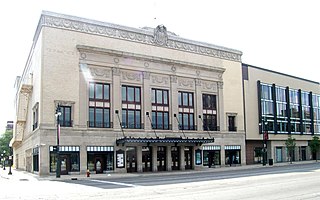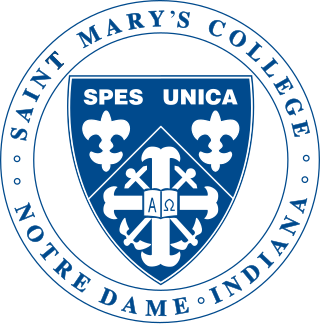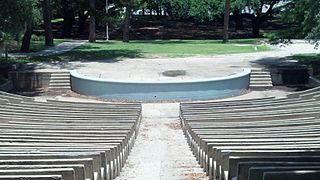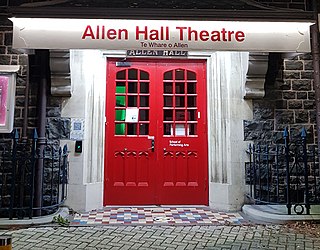
Purdue University is a public land-grant research university in West Lafayette, Indiana, and the flagship campus of the Purdue University system. The university was founded in 1869 after Lafayette businessman John Purdue donated land and money to establish a college of science, technology, and agriculture; the first classes were held on September 16, 1874.

Orchestra Hall is an elaborate concert hall in the United States, located at 3711 Woodward Avenue in Midtown Detroit, Michigan. The hall is renowned for its superior acoustic properties and serves as the home of the internationally known Detroit Symphony Orchestra (DSO), the fourth oldest orchestra in the United States. With the creation of an adjoining auditorium for jazz and chamber music in 2003, Orchestra Hall became part of the Max M. and Marjorie S. Fisher Music Center. It was listed on the National Register of Historic Places in 1971.

The Royal Festival Hall is a 2,700-seat concert, dance and talks venue within Southbank Centre in London, England. It is situated on the South Bank of the River Thames, not far from Hungerford Bridge, in the London Borough of Lambeth. It is a Grade I listed building, the first post-war building to become so protected. The London Philharmonic Orchestra, the Philharmonia Orchestra, the Orchestra of the Age of Enlightenment, the London Sinfonietta, Chineke! and Aurora are resident orchestras at Southbank Centre.

Alumni Stadium is a football stadium located on the lower campus of Boston College in Chestnut Hill, Massachusetts, approximately 6 miles (9.7 km) west of downtown Boston. It is the home of the Boston College Eagles. Its present seating capacity is 44,500.

Saint Mary's College is a private Catholic women's liberal arts college in Notre Dame, Indiana. Founded in 1844 by the Sisters of the Holy Cross, the name of the school refers to the Virgin Mary.

West Virginia State University (WVSU) is a public historically black, land-grant university in Institute, West Virginia. Founded in 1891 as the West Virginia Colored Institute, it is one of the original 19 land-grant colleges and universities established by the second Morrill Act of 1890, which evolved as a diverse and inclusive campus. Following desegregation, WVSU's student population slowly became more white than black. As of 2017, WVSU's student body was 75% white and only 8% African-American.

The Queen Elizabeth Hall (QEH) is a music venue on the South Bank in London, England, that hosts classical, jazz, and avant-garde music, talks and dance performances. It was opened in 1967, with a concert conducted by Benjamin Britten.

Notre Dame Stadium is an outdoor football stadium in Notre Dame, Indiana, the home field of the University of Notre Dame Fighting Irish football team.

Hill Auditorium is the largest performance venue on the University of Michigan campus, in Ann Arbor, Michigan. The auditorium was named in honor of Arthur Hill (1847–1909), who served as a regent of the university from 1901 to 1909. He bequeathed $200,000 to the university for the construction of a venue for lectures, musical performances, and other large productions. Opened in 1913, the auditorium was designed by Albert Kahn and Associates. It was renovated by the same firm beginning in 2002 and was re-opened in 2004.

WBAA and WBAA-FM (101.3 FM) are jointly operated non-commercial educational radio stations licensed to West Lafayette, Indiana, United States, both serving the Lafayette metro area and the Indianapolis area with public radio formats. The stations were founded by Purdue University, but in 2022, 100 years after WBAA's start, ownership was transferred to Metropolitan Indianapolis Public Media, Inc. (MIPM), which also owns WFYI radio and television in Indianapolis. Both stations originate from studios in the Edward C. Elliott Hall of Music on the Purdue campus, with transmitter sites south of Lafayette at the Throckmorton Purdue Agricultural Center.

The Slayter Center of Performing Arts is located on the main campus of Purdue University in West Lafayette, Indiana, United States. It is an outdoor concert bandshell completed in 1964 and dedicated May 1, 1965. The facility was a gift from Games Slayter and his wife Marie.

Convocation Hall is a domed rotunda on the grounds of the University of Toronto in Toronto, Ontario, Canada. Designed by Darling and Pearson and completed in 1907, its radially planned interior has been compared to the grand amphitheatre of the Sorbonne and the Sheldonian Theatre at Oxford, although no specific precedent is truly known. While the building's namesake purpose is to host the annual convocation ceremonies, it also serves as the venue for academic and social functions that involve large audiences throughout the year.

The Indiana University Jacobs School of Music in Bloomington, Indiana, is a music conservatory established in 1921. Until 2005, it was known as the Indiana University School of Music. It has more than 1,500 students, approximately half of whom are undergraduates, with the second largest enrollment of all music schools accredited by the National Association of Schools of Music.

The Krannert Center for the Performing Arts is an educational and performing arts complex located at 500 South Goodwin Avenue in Urbana, Illinois and on the campus of the University of Illinois Urbana-Champaign. Herman C. Krannert, an industrialist who founded Inland Container Corporation and an alumnus of the university, and his wife, Ellnora Krannert, made a gift of $16 million that led to the Krannert Center's construction. Max Abramovitz, the architect who designed the facility, was also an Illinois alumnus.

Frederick Lawson Hovde was an American chemical engineer, researcher, educator and president of Purdue University.

The California Vulcans are the intercollegiate sports teams and players that represent Pennsylvania Western University California, located in California, Pennsylvania. The Vulcans participate in the NCAA Division II in all sports and the Pennsylvania State Athletic Conference (PSAC) in most sports. The school colors are Red and Black. The mascot of California is Blaze the Vulcan.

The Stroh Center is a multi-purpose arena on the campus of Bowling Green State University in Bowling Green, Ohio, United States. It replaced Anderson Arena as the home of the Bowling Green Falcons men's and women's basketball and women's volleyball teams, and hosts music concerts and the university's commencement ceremonies. The arena was designed by the architectural firm Rossetti Architects, designers of Red Bull Arena and Rio Tinto Stadium, and engineering firm URS Group Inc. The building opened in September 2011 and seats 4,387 people for basketball and volleyball games and 5,209 for convocation events and concerts.
The Bagdad Supper Club was a theater and entertainment venue located on north side of what then was U.S. Route 80, but now is Texas State Highway 180, east of Grand Prairie, Texas, at the corner of Bagdad Road and Main Street. It opened Thanksgiving Day 1928, eleven months before the Great Crash of 1929. It was an opulent palatial facility that offered dining, dancing, and music. The venue was featured in the 1947 comedy Juke Joint, starring Spencer Williams. J. Wiley Day was the inaugural managing director. The club was constructed by the Bagdad Enterprises, Inc., a Texas corporation, controlled by Eastern capital. The corporation was a subsidiary of a large Eastern company that confined itself to various theatrical lines. The architect was W. Scott Dunne (1886–1937), a well-known designer of theaters in Texas.

The Greek Theatre in Baton Rouge, Louisiana is located on the campus of Louisiana State University. It opened in 1925 with seating for approximately 3,500. It was built to hold the entire university population and was once the location of major university assemblies.

Allen Hall, also known as the Allen Hall Theatre, is a building at the University of Otago in Dunedin, New Zealand. It is named after James Allen, Vice-Chancellor and then Chancellor of the university, who was instrumental in raising funds for building the hall. Originally the student association building, opened in 1914, the hall now operates as a theatre. Allen Hall is known for the series of Lunchtime Theatre performances. The hall and archway are registered as a Category I historic place by Heritage New Zealand.






















